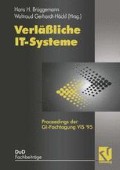Zusammenfassung
Intrusion Detection stellt eine in Audit integrierte Sicherheitsfunktion zur automatisierten Erkennung von Angriffen in Systemen bzw. Netzen dar. Nach einem fragmentarischen Einstieg in die Thematik werden prinzipielle Herangehensweisen an die Analyse von Auditdaten vorgestellt. Ausgehend von einer kritischen Wertung der in den ITSEC sowie den Federal Criteria enthaltenen, für Intrusion Detection relevanten Empfehlungen werden Notwendigkeit und Möglichkeiten der Berücksichtigung datenschutzrechtlicher Rahmenbedingungen und deren technische Durchsetzung bei Systemgestaltung und Einsatz von Intrusion Detection-Systemen erörtert. Daran anschließend wird mit AID2 (adaptive intrusion detection & defense system) ein derzeit in Realisierung befindliches Intrusion Detection-System vorgestellt, dem ein datenschutzkonformes Systemkonzept zugrundeliegt.
Access this chapter
Tax calculation will be finalised at checkout
Purchases are for personal use only
Preview
Unable to display preview. Download preview PDF.
Literatur
Betriebsverfassungsgesetz, Novellierung vom 18. Dezember 1989
Bundesamt für Sicherheit in der Informationstechnik (BSI): Kriterien für die Bewertung der Sicherheit von Systemen der Informationstechnik, Bundesanzeiger, Köln, 1992
Bundesdatenschutzgesetz, Novellierung vom 20. Dezember 1990
Canadian System Security Center, The Canadian Trusted Computer Product Evaluation Criteria, Version 3. 0, April 1992
CS Telecom, Hyperview. Product description, September 1994
Commission of the European Communities, Information Technology Security Evaluation Criteria, Version 1.2, Office for Official Publications of the European Communities, Luxembourg, June 1991, Catalogue number: CD–71–91–502–EN–C
Communications-Electronics Security Group, UK Systems Security Confidence Levels, CSEG Meorandum No. 3, United Kingdom, January 1989
Debar, H., Becker, M., Siboni, D., A neural network component for an intrusion detection system, Proc. of the IEEE Symposium on Research in Computer Security and Privacy, Oakland, CA, May 1992
Denning, D. E., An intrusion detection model, Proc. of the IEEE Symposium on Security and Privacy, Oakland, CA, April 1986, pp. 184–194
Denning, D. E., Neumann, P. G., Parker, D., Social aspects of computer security, Proc. of the 10th NCSC, Baltimore, MD, Oct. 1987, pp. 320–325
Department of Defense, Trusted Computer Security Evaluation Criteria, (Orange Book), DoD 5200.28-STD, December 1985
Fischer-Hübner, S., IDA (Intrusion Detection and Avoidance System): Ein einbruchserkennendes und einbruchsvermeidendes System, Dissertation am Fachbereich Informatik der Universität Hamburg, Shaker, Aachen, 1993
Fischer-Hübner, S., Brunnstein, K., Opportunities and risks of intrusion detection expert systems, Proc. of the International IFIP-GI-Conference ORAIS `89, Universität Hamburg, Juli 1989, S. 317–323
Fox, K. L., Henning, R. R., Reed, J. H., Simonian, R. P., A neural network approach towards intrusion detection, Proc. of the 13th NCSC, Washington, D.C., Oct. 1990, pp. 125–134
Gehrke, M., Pfitzmann, A., Rannenberg, K., Information Technology Security Evaluation Criteria (ITSEC) - a Contribution to Vulnerability?, Proc. of the IFIP 12th World Computer Congress, Madrid, Sept. 1992
Grimm, R., Sicherheit für offene Kommunikation: Verbindliche Telekooperation, BI-Wissenschaftsverlag, Mannheim, Leipzig, Wien, 1994
Grundgesetz
Habra, N., Le Charlier, B., Mounji, A., Mathieu, I., ASAX: Software architecture and rule-based language for universal audit trail analysis, Proc. of the ESORICS `92, Toulouse, November 1992, pp. 434–450
Halme, L.R., van Horne, J., Automated analysis of computer systems audit trails for security purposes, Proc. of the 9th NCSC, Sept. 1986, pp. 71–74
Haystack Laboratories, Inc., Info on Stalker, Sept. 1994
Intrusion Detection: The State of the Art, Data Security Letter no. 22, November 1990, pp. 4–7
Tying, R. H., Higgins, C. A., Safayeni, F. R., Computerized Performan-ce Monitoring Systems: Use and Abuse, CACM 29(1986)8, pp. 794–801
Lunt, T. et. al., A Real Time Intrusion Detection Expert System (IDES)-Final Report, SRI International, Menlo Park, CA, Feb. 1992
National Computer Security Center, A Guide to Understanding Audit in Trusted Systems, NCSC-TG-001, Version 2, June 1988
Pfitzmann, A., Rannenberg, K., Staatliche Initiativen und Dokumente zur IT-Sicherheit. Eine kritische Würdigung, Computer und Recht 3/93, S. 170–180
Pfitzmann, B., Waidner M., Pfitzmann, A., Rechtssicherheit trotz Anonymität in offenen digitalen Systemen, Teil 1, Datenschutz und Datensicherung 6/90, S. 243–253, Teil 2, 7/90, S. 305–315
Rihaczek, K., Bemerkungen zu den harmonisierten Evaluationskriterien für IT-Sicherheit, Proc. der VIS’91 (GI-Fachtagung), Darmstadt, März 1991, S. 259–276
Rihaczek, K., Intrusion Detection, (Editorial), Datenschutz und Datensicherung 10/92, S. 505
Schaefer, L. J., Employee Privacy and Intrusion Detection Systems: Monitoring on the Job, Proc. of the 14th NCSC, Washington, D.C., Oct. 1991, pp. 188–194
Seiden, K. F., Melanson, J. P., The audit facility for a VMM security kernel, Proc. of the IEEE Symposium on Security and Privacy, Oakland, CA, May 1990, pp. 262–277
Service Central de la Sécurité des Systèmes d’Information, Catalogue de Critères Destinés a Evaluer le Degré de Confiance des Systèmes d’Information, 692/SGDN/DISSI/SCSSI (Blue-White-Red-Book), Juli 1989
Snapp, S. R. et. al., DIDS–Motivation, architecture, and an early prototype, Proc. of the 14th NCSC, Washington, D.C., Oct. 1991, pp. 167–176
Teng, H., Chen, K., C-Y Lu, S., Adaptive real-time anomaly detection using inductively generated sequential patterns, Proc. of the IEEE Symposium on Security and Privacy, Oakland, CA, May 1990, pp. 278–284
United States National Institute for Standards and Technology & National Security Agency, Federal Criteria for Information Technology Security, Version 1. 0, Dec. 1992
Vaccaro, H. S., Liepins, G. E., Detection of anomalous computer session activity, Proc. of the IEEE Symposium on Security and Privacy, Oakland, CA, May 1989, pp. 280–289
Zentralstelle ftir Sicherheit in der Informationstechnik (Hrsg.), IT-Sicherheitskriterien: Kriterien für die Bewertung der Sicherheit von Systemen der Informationstechnik, Bundesanzeiger, Köln, 1989
Author information
Authors and Affiliations
Rights and permissions
Copyright information
© 1995 Springer Fachmedien Wiesbaden
About this chapter
Cite this chapter
Sobirey, M. (1995). Aktuelle Anforderungen an Intrusion Detection-Systeme und deren Berücksichtigung bei der Systemgestaltung von AID2 . In: Verläßliche IT-Systeme. DUD-Fachbeiträge. Vieweg+Teubner Verlag, Wiesbaden. https://doi.org/10.1007/978-3-322-91094-3_22
Download citation
DOI: https://doi.org/10.1007/978-3-322-91094-3_22
Publisher Name: Vieweg+Teubner Verlag, Wiesbaden
Print ISBN: 978-3-528-05483-0
Online ISBN: 978-3-322-91094-3
eBook Packages: Springer Book Archive

